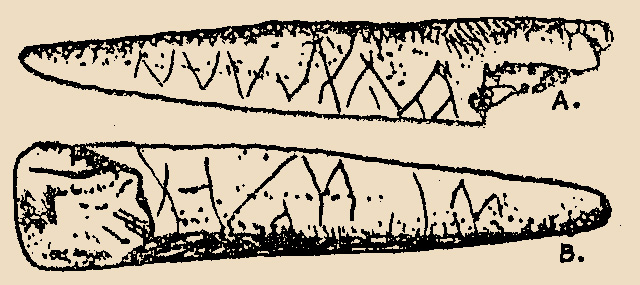|
|
|
The Oldest Relic of ancient Hungarian Writing in the Carpathian Basin
|
|
|
The Oldest Relic of ancient Hungarian Writing in the Carpathian Basin |
Our country's oldest relic, so far, the end-piece of a staff with incised writing, turned up in the Pilis [mountain] near [the village] Bajót. I discovered its picture in a book titled The Prehistoric Man, written by Kálmán Lambrecht (Edition Dante, 1931). I published this picture in a book, on page 115, collectively written with Gábor Szakács From the Summit of Tászok to the Bosnian Pyramids. I also included this in another publication Studies of Hungarian Erudition, edited by László Botos, on page 283.
 |
|
Only
the following is found about the end-piece of the staff in Kálmán Lambrecht's
splendid book: "The vestige of prehistoric man's art in Hungary.
A zigzag-adorned stick from the Magdalenian cultural stra-tum in the Jankovich
cavern of Bajót. Original size."
|
To sum up, Kálmán Lambrecht concluded the scores to be purely ornamental. In my opinion, however, we can perceive them as well identifiable letters of our ancestral writing. [Consequently,] I strived to learn as much as possible about this find. László Vértes states in his book The Relics of the Paleolithic Age and the Transitional Stone Age in Hungary (Academic Edition, 1965): "The finds in the Jankovich cavern constitute, on the Danube's west side, the only aggregate of the Szeleta [epoch] that can be measured statistically. The cavern, which opens toward the north under the peak of Öregkő in the vicinity of Bajót, was excavated by Hillebrand from 1913 to 1925,..."
We can obtain some knowledge from the personage of the explorer, Jenő Hillebrand (1884-1950), similarly by László Vértes: "...the pre- historic archeologist's...refined logic, his professional attainments and, last but not least, his love of his profession built the system of the Hungarian prehistoric findings, and made their valuable subject matter well-known."
In his book, The Prehistory
of Hungary (Budapest, 1935), Hillebrand does not include a description of
this find, yet shows it among his
photographs.
In the literature, the period
of the Jankovich cavern's finding is set between the Magdalenian and the Szeleta
epochs, namely, between 15,000 and 41,000 years. Hence, the age of the end-piece
of our staff is placed between these two periods. No mention is made, however,
about the material of the staff's end-piece. By taking into
consideration its age, it is likely that the find was polished from bone or
from an antler. The stipulation about the find's age and material is sup- ported
by spear-tips from the cave of Istállóskő [in the Bükk moun- tain]. These, too,
were made from bones or antlers, albeit without markings, and can be viewed
at the Hungarian National Museum. The age of these varies from 30,000 to 35,000
years.
Kálmán Lambrecht declares the drawing appearing in his book to be of original [i.e. same] size. Based on this, the broken end of the staff is 38 mm long and is 8 mm broad at its widest part. Its function may have been the tip of a spear.
The `A" side's signs (above) are, from right to left: clever ligature of the letters SK, grouping of G or BG, ingenious assemblage of letters BSO, as well as K and V, or two figures of five and the letter K.
The `B" side's signs (below) are, from right to left: ligature of the letters V and L, grouping of SV and two V (vess? or véss?-in Hungarian), then another ligature of BR before the fracture.
The above identification of letters are only valid, naturally, if the drawing is accurate. Very likely that the broken-off missing part also contained markings. In my opinion, the writing started on the `A" side of the stick, advancing toward the pointed end, then continued on the `B" side, starting at its point.
The importance of the find constitutes our oldest written relic in the Carpathian Basin. On it, the nowadays still used and currently known as ancient Hungarian script's letters, maybe even a word, is recognizable. From all this, the following significant attainment can be derived pertaining to our prehistory's standpoint:
- in one respect, we can support our very early presence in the Carpathian Basin with significantly older script than that on the Tatárlaka disk [in Transylvania],
- in other respect, the Hungarians already used, during that period, the most advanced mode of recording letters, where each sound is represented by a unique character. With this method, messages can be created with ease, not like with the cumbersome picture-writing, ideogram, or syllabic script.
Klára Friedrich
Budapest, 2007, október
Translated by: Károly
Bartha
|
|
|
The Oldest Relic of ancient Hungarian Writing in the Carpathian Basin
|
|
|